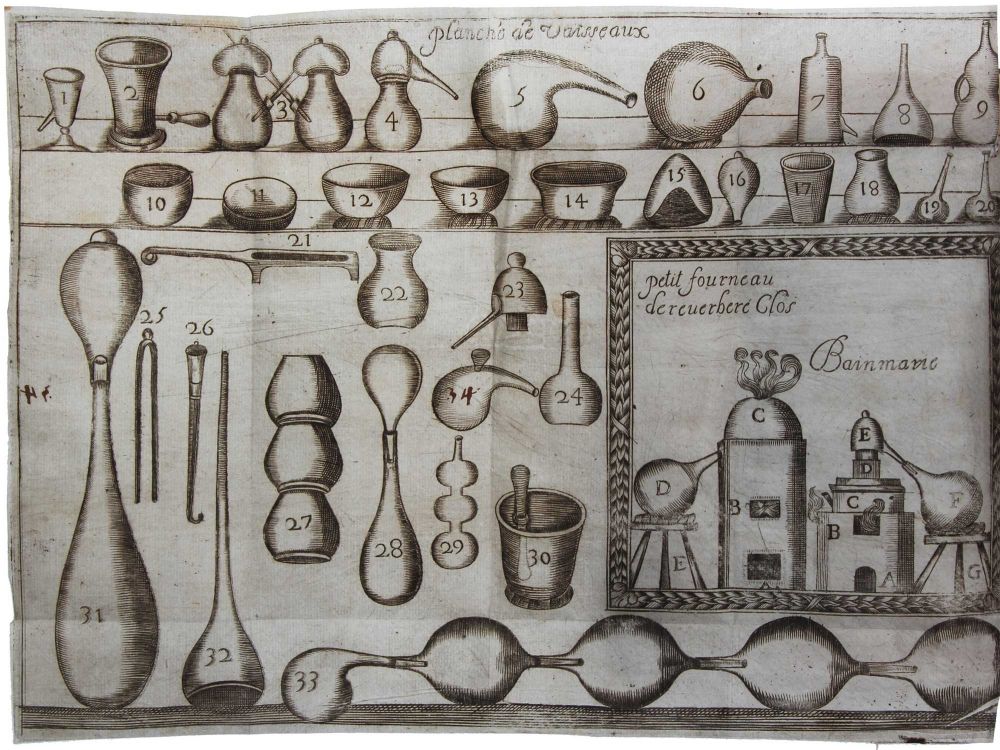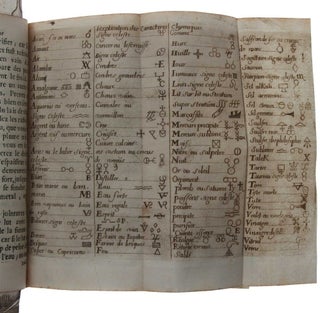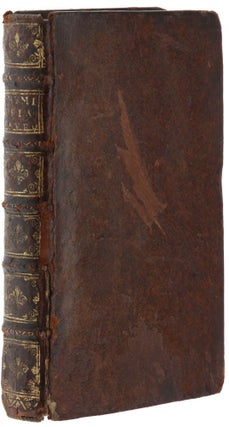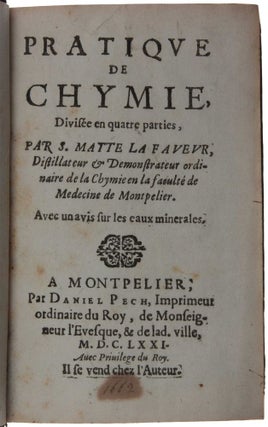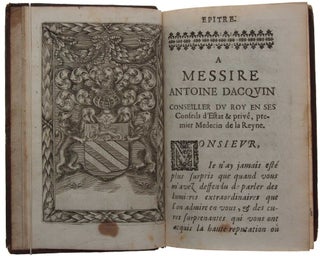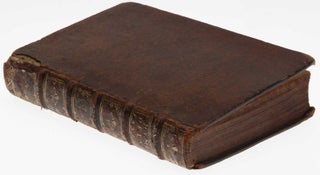Pratique de chymie, divisée en quatre parties, par S. Matte La Faveur, distillateur & demonstrateur ordinaire de la chymie en la faculté de Medecine de Montpelier. Avec un avis sur les eaux minerales.
Montpelier: Daniel Pech, 1671. First edition, very rare, of this important work, of which “less than a dozen copies are known to exist, most imperfect” (The Roy G. Neville Historical Chemical Library, vol. 2, p. 153. “Sold only by the author at his home in Montpellier, the Pratique contains clear directions on practical operations and the preparation of chemicals. Matte la Faveur, distiller and demonstrator of chemistry at Montpellier, simultaneously gave a course at Paris until 1684, when he was succeeded by the famous chemist Nicolas Lemery. Undoubtedly, Lemery used this work when writing his celebrated Cours de Chymie (1675), and it is well known that he seldom acknowledged his sources. The Pratique forms a direct link between the Traité de la Chymie (1663) of Christophle Glaser and the Cours of Lemery” (Neville). Matte’s Pratique de chymie gives a good indication of his teaching of the subject. He defined chemistry in its relation to medicine. It was ‘the Art of separating the parts of a natural body, purifying them, and reuniting them for their use in Medicine. His elementary substances were phlegm, spirit, sulphur, salt, and ‘terre morte’, the most commonly accepted groups from this period. After a description of chemical operations and equipment he devoted the remainder of his book to chemical preparations, which he divided into the customary categories of mineral, vegetable, and animal” (Debus, p. 144). “Matte la Faveur adopts the traditional Aristotelian distinction between perfect and imperfect mixts, which he interprets in vague corpuscular terms. Imperfect mixts, he says, are those which can easily be decomposed by heat; perfect ones are those which resist the action of heat, because their parts have a closer union. The chemical principles, he asserts, are not the same in the three kingdoms of nature. Volatility, he states, is a relative quality. Though mercury is the most volatile among the principles, salts too are volatile, though in different degrees. The same principle can be more or less volatile, according to the natural kingdom from which it originates. The principles of minerals are the most fixed, those extracted from vegetables are the most volatile” (Clericuzio, p. 170). OCLC lists copies in US at Cornell, University of Delaware, Dickinson College, Harvard, University of Pennsylvania, Science History Institute (Othmer Library), Washington State, and University of Wisconsin-Madison. ABPC/RBH list three copies in the last 30 years. Assembled by the author himself, apparently in a somewhat haphazard manner, the make-up of different copies varies. Sebastien Matte la Faveur (1626-1714) was one of the most important chemists and pharmacists in 17th century France. The son of a master glassmaker from Haute-Ardèche, he was self-taught. His discovery of styptic water and other research led to a professorship at the University of Montpellier. His lavender distillate known as “the water of the queen of Hungary” (Aqua Reginae Hungariae), earned him the title of “pharmacies particulier du Roi Louis XIV” and another chair at the Sorbonne. In 1684 his position in Paris was taken over by Nicolas Lemery, who acknowledged that he used this work in the preparation of his Cours de Chymie (1675). He was knighted by Louis XIV who extended his surname Matte to ‘Matte La Faveur’. Matte la Faveur “opened his Pratique de chymie of 1671 with a preface to the reader excusing himself for publishing another ‘Cours de Chymie’. Beguin, Hartmann, Croll, Quercetan (Du Chesne) and Schröder – had they not already taught all these preparations? And didn’t it seem that in his time in France Davisson, Lefebure (Le Fèvre) and Glazer (Glaser) had left nothing new to say? But his fellow physicians have pressed him to publish and he has succumbed at last. He claims to offer some new preparations and to discover short cuts and easier methods to perform the most difficult operations. But rather than merely note his innovations, he has decided to set forth the entire subject, although this involves repetition of what others have said … “The work divides into four books, of which the first deals with definition, elements, operations and apparatus. Book II is concerned with the principal preparations of minerals; III, of vegetables; IV, of animals, with a supplementary Advis concerning mineral waters, telling how to recognize what they contain. Several inserted folded plates illustrate chemical symbols and apparatus, but offer nothing unusual. “Chemistry is defined as the art of separating the parts of natural bodies, of purifying them, and then putting them together again for medical purposes, and the author limits his book to practical chemistry. He deprecates indulging in physical theory before knowing mechanics and chemistry. In dissolving compounds by fire one discovers five underlying substances: phlegm, an insipid liquor in the form of water; spirit, the most active and volatile part of the compound; sulphur or oil, which is the most combustible part; salt; and dead earth. Each of the three active principles – salt, sulphur and mercury – is different in each of the three kingdoms – animal, vegetable and mineral. Salts are natural or artificial; the latter, simple or composite, like sal armoniac. Simple salts subdivide into lyes, essentiels and volatile. Oil of tartar is not properly an oil, but a salt dissolved. “By chemical operations are obtained powders: minerals reduce to calx, animals and vegetables, to cinders or ashes. ‘Alkool est une poudre très subtile et impalpable.’ Flowers and sublimations are the subtlest parts of bodies. Waters are liquors produced by distillation, and are called spirits, if they are free from phlegm and very spirituous. “Perfect animals are those whose parts cease to move when separated from the heart. Imperfect animals are those whose parts continue to move for some time after they have been separated from the heart. “Processes with gold include cupellation, purification by antimony, amalgamation or calcination by mercury, crocus solis or or fulminant, liqueur d’or or potable gold, to which medical effects are ascribed. Crocus solis, too, is employed in medicine, six, seven or eight grains being given in a syrup suited to the malady. It is further a specific for sufferers from mercury ointment, as it detaches the mercury from the body and unifies it to itself. Mixed with equal parts of mineral bezoar, it is good for smallpox; it checks vomiting and strengthens the stomach. “Ordinarily, to dissolve coral, spirits of vinegar or lemon juice are used or ‘esprit de vitriol philosophique’ (an acid drawn by lotions from butter of antimony). But Matte la Faveur prefers to use spirits of copper (l’esprit de Venus) to dissolve corals or pearls. Four chapters on amber are on its oil and the magistere, essence and elixir of ambergris. Preparations from animals include a volatile salt of vipers, another of human blood, and spirit, oil and salt of hartshorn. “Among bits from the author’s own experience the following may be noted. Under the caption of Laudonum opiatum he remarks that opium receives no virtue from the waters or spirits with which it is mixed. For when in Italy he used it successfully without other preparations than this. One day in Grenoble he saw a viper-catcher who was wounded by one in the arm. He immediately cut off the heads of two vipers, tore out their hearts and devoured them. ‘I went to his house two or three days later to learn the outcome. I found him in perfect health, and he told me that it was not the first time that he had availed himself of that remedy.’ “Two examples of chemical experiment may also be noted. Catch toads, tie them by the hind legs, hang them in the chimney-place and leave them there until they are dried. Then clean them and wash them with eau de vie, dry them in the sun. When you have about fifty, chop them into bits and make spirits, oil and volatile salt of toads. Life was full of perils for toads even before the advent of electric light and the automobile. “For volatile salt of urine take about sixty pints of the urine of little children aged six or seven who drink very little wine. Put them in various hermetically sealed receptacles and leave these in horse manure or the sun for a month or six weeks to corrupt. Then distill four pints at a time down to one pint. Re-distill these fifteen pints in a bain-Marie in vessels with long necks and draw off about five or six pints and put in a glass vessel adding a pound and a half of saltpetre refined and dried. After more heatings and distilling the final outcome is about eight ounces of crystalline salt which must be kept in a tightly corked bottle, or the air will dissipate it” (Thorndike, pp. 141-144) Caillet, 7225; Dorbon-Aine, 6273; Duveen, 395; Ferchl, 345; Goldsmith, M669; Neu, 2681; Partington, 111, 27; Poggendorff, 11, 78; Sotheran, Cat. 800 [1926], 11519; Thorndike, VIII, 141; Thornton 8c, Tully, 122. Clericuzio, Elements, Principles and Corpuscles: A Study of Atomism and Chemistry in the Seventeenth Century, 2013. Debus, The French Paracelsians: The Chemical Challenge to Medical and Scientific Tradition in Early Modern France, 2002. Thorndike, A History of Magic and Experimental Science, Vol. VIII, 1958.
8vo (158 x 100 mm): pp. [x], 360, 10 (explanatory leaves), [xxxii], with engraved armorial frontispiece, 13 engraved plates, and 12 folding leaves including a table of chemical symbols (brown spot at foot of title partly obscuring the date ‘1662’ written in manuscript). Contemporary full calf, spine with five raised bands, richly gilt in compartments with floral vignettes and gilt title, edges mottled red (joints cracked but firm, capitals worn). An entirely unrestored copy of this very important and rare book.
Item #3380
Price: $15,250.00

